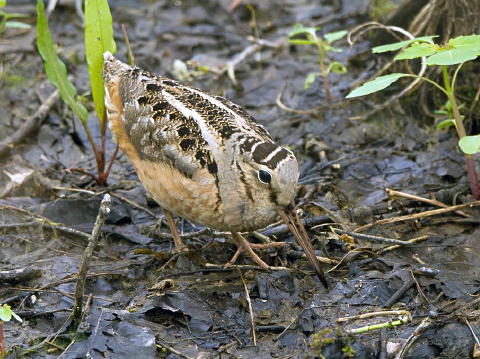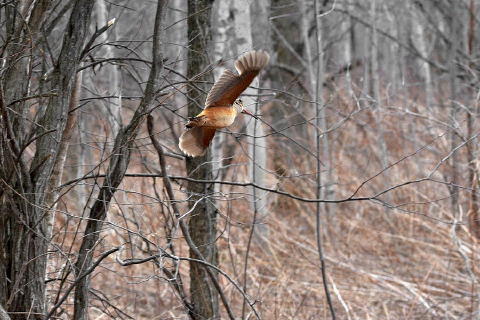STALKING TIMBER DOODLES - Russ Richardson, Forester


By Russ Richardson
Growing up on a small farm in western Massachusetts during the 1950s, nearly all my waking time when I wasn't in school, I spent outside. Each season had its own unique set of features that I began to appreciate more as the years passed and I developed a better understanding of the natural world.
Winters in New England were harsh in the 1950s and I can remember many times the snow drifts were far over my head and seemed to take forever to melt away in spring. It was at the end of one of those long winters during one of the earliest warm afternoons of the spring when I encountered my first American woodcock.
I was walking in an alder thicket surrounding the swamp and beaver pond, that also doubled as our playground, when this strange round bird with a long beak and big eyes exploded in flight in front of me.
The sudden flight of the bird startled me but the image of it was so memorable that I was able to describe it to my school bus driver, Mr. Green, an avid and well-known bird watcher, who immediately identified the bird as an American woodcock. Being the young kids, we were, all we could do was snigger, laugh and make jokes about the funny sounding name of the bird.
In addition to serving as our school bus driver, Mr. Green was also the Scoutmaster of our local Boy Scout Troop and an active member of the Massachusetts Audubon Society.
During the years riding his bus I can recall him regularly stopping the school bus along the way home to point out uncommon birds like mockingbirds and cardinals, or noting the spring arrival of the red-winged blackbirds, swallows and bluebirds.
Mr. Green was the first person I knew who said that contrary to what our grandparents and parents might say, there is no such thing as a "chicken hawk" and people shouldn't shoot them.
A couple years later, during one of our Friday night Boy Scout meetings, Mr. Green took us to an old hay field located on his farm, a couple miles from the Scout House, providing an experience that began my lifelong fascination with American woodcock, also known by many people as a snipe or timber doodle.
On that March night, Mr. Green took us to an upland meadow surrounded by swampy brush and abandoned pastures. After we walked a couple hundred feet from where he parked his station wagon, he asked us to stand still, be quiet and listen.
As I stood quietly in the fading twilight uncertain what I was waiting for, a male American woodcock took flight and performed a spring mating ritual that has drawn me back to old meadows, alder thickets and pastures, hundreds of times, along with untold numbers of uninitiated friends and forestry clients.
I soon learned that the American woodcock is nocturnal and one of the first migratory birds to arrive in New England after the winter thaw when the snow begins to melt in earnest. The short-legged, round bird with unusually big eyes, that almost no one ever sees, uses its' long beak to probe the moist spring soil, feeding on snails, insect larvae and earthworms.
Almost immediately after arriving North, the woodcock will begin performing a unique mating ritual beginning within minutes of sunset on calm, early spring nights.
The song or call of a woodcock in the midst of a mating display is rapid tweetering while in flight and is a sharp nasally "whaaack" while on the ground that cannot be confused with any other bird.
Because American woodcock spend most of the time silently sitting, nesting and hunting on damp ground or the forest floor and are so difficult to flush, few people ever actually encounter them until they explode in flight when disturbed. I was always amazed how most people failed to notice a noisy round-looking black blob flying circles in the twilight and soon found the spectacle of the American woodcock mating display is an event savored by few and lost to most.
During the mating ritual, the male woodcock will select a small bush or brush pile in or near an old field to serve as a display ground take-off, landing and calling spot. Every minute or so he will make a nasally "whaaack" sound.
After a few minutes sitting still, the bird will take flight. At first, he will fly the perimeter of his chosen "display ground" making a high-pitched "tweetering" sound. As he flies the perimeter, the male woodcock will gradually climb in elevation in a series of spiraling concentric circles that become smaller in diameter the higher he gets.
The display reaches a climax as the birds' tweetering noise takes on a desperate breathless tone and he begins to sound more like a sputtering plane engine about to quit than a bird. Suddenly, the "tweetering" ends, the bird stops flying and drops like a rock straight to the ground and towards the spot from which he flew.
After a few seconds sitting quietly, he will send out a loud "whaaack" to see if any females respond to his courting display. When no one answers his call, he will continue to repeat the ritual until just before dawn.
Through careful observation, locating the birds' resting spot and using calm and deliberate, movement, it is possible to get extremely close to the landing spot and calling ground of a male woodcock. After identifying the general location of the "spot" the bird is calling from, make a very slow approach to the site, moving only while the bird is in flight.
Depending upon how brushy the area is, within a hundred feet of the "spot", continue the approach by dropping to your hands and knees and moving just a few feet each time the bird is busy in flight. Wait until he has flown several circles and has started to gain in elevation before crawling forward. It can take half an hour or longer to stalk a woodcock to the closest vantage point possible but it will provide a memory worth the effort.
As impressive as it is to listen to their spastic tweetering and watch the shadowy silhouette of a woodcock circle you during his courting display, the thrill of crawling to within a foot of his landing spot and watching a bird, highlighted by the partially full moon and bright early stars of the approaching night, fall straight towards you from above, completely unaware of your presence.
I never left such an encounter without wondering how a woodcock can wait until they are within a foot of the ground before slamming on their feather brakes and safely land without crashing and dying.
Safe landings are probably one of the traits their prospective mates are looking for but it is also one of the best reasons for watching their display. The "whaaack" call he makes shortly after landing lets you know all is well in the woods. During his next flight, it will be OK to stand up and slowly walk away without disturbing his ongoing "display".
The American woodcock is commonly encountered in Calhoun, Roane, Wirt and surrounding counties anywhere there is a combination of old fields and brushy, wet, land that is free of grazing livestock. Until mid-April, when the foliage comes out, it may be possible to witness their display on nearly any calm clear night.
The easiest and first step of the process is to go to a quiet location away from town that shares habitat conditions similar to those already described and listen for the "whaaack" sound of a male woodcock looking for a mate.
Remain quiet and listen for the sound of "tweetering" in the distance in case there is more than one male displaying at the site. Approach the area quietly and enjoy the show.